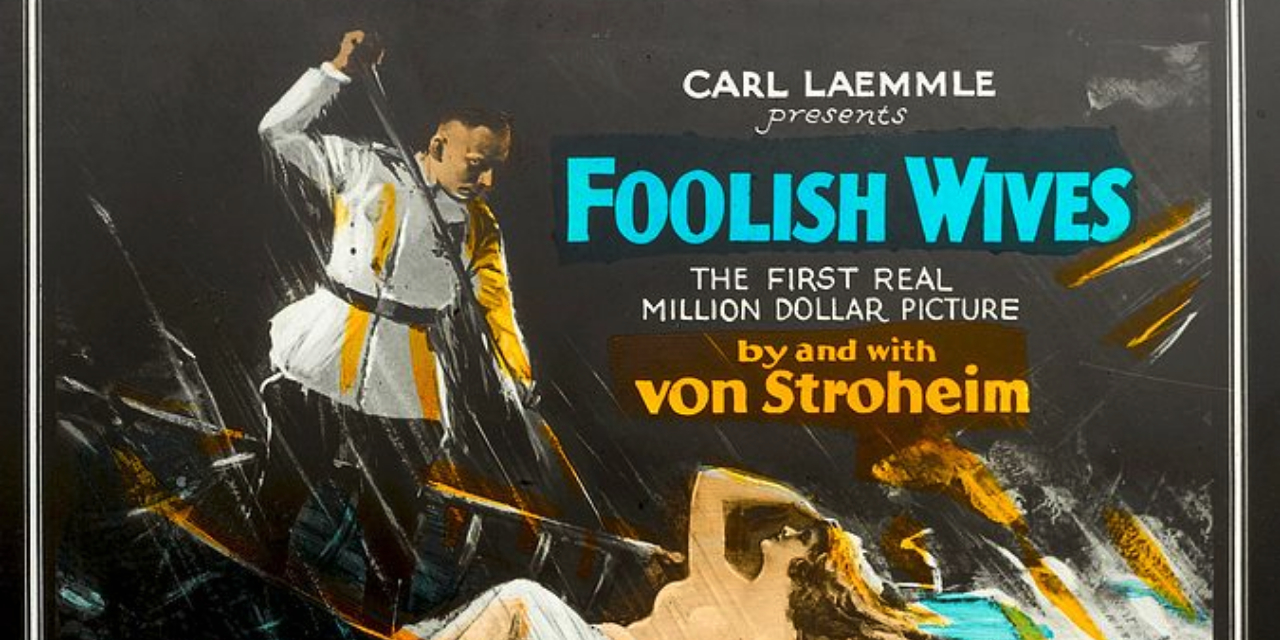Der teuerste Film seiner Zeit und von Universal als das erste „Million Dollar Movie“ Hollywoods angekündigt, was das Studio aber nicht davon abhielt, von Strohheims – zugebenermaßen megalomanische – Vision eines Spielfilms mit einer Laufzeit von „6 bis 10 Stunden“ radikal auf zunächst gut 210 Minuten einzukürzen und später auf 117 Minuten zu verstümmeln (die Universal-Langversion ist wie von Strohheims Vision verschollen, es existiert aber ein auf immerhin 142 Minuten rekonstruierter Print, der derzeit auf MUBI zu sehen ist).
„Foolish Wives“ baut Monte Carlo in Kalifornien nach (was übrigens keine Redewendung, sondern buchstäblich gemeint ist, siehe die Anekdote unten!) und erzählt eine verschlagene, bösartige Geschichte um einen falschen Aristokraten (ein phänomenaler, monokeltragender, schlank und ranker von Strohheim selbst mit dem akkuratesten Haarschnitt der Filmgeschichte), der auf der Suche nach Geld und Sex vor nichts halt macht, mit falschen Tränen sein Dienstmädel um 2.000 Franc betrügt, zu einer geistig zurückgebliebenen Tochter eines verarmten Witwers ins Bett steigt und mit intriganten Winkelzügen eine amerikanische Touristin zum Fremdgehen verführt. Es nötigt bereits ohne Kenntnis der Produktionsvorkommnisse einigen Respekt ab, dass von Strohheim mit *dieser* Geschichte Universal das Geld für das teuerste Filmset der Geschichte aus den Taschen leiern konnte!
Noch unterhaltsamer als der auch in seiner reudzierten Fassung gute Film wäre wahrscheinlich eine Dokumentation über seine Entstehung, also ein „Burden Of Dreams“ zu von Strohheims „Fitzcarraldo“ mit seinen 11 Monaten Drehzeit, 6 Monaten Schnittzeit, während des Drehs verstorbenem Hauptdarsteller und 15.000 Statisten.
Einige der bizarrsten Anekdoten:
– Erich von Stroheim’s attention to detail was such that he ordered an engraver to print copies of French money as props for the movie (he was playing the role of a counterfeiter). Unfortunately, the money printed was realistic enough that, shortly before shooting began, von Stroheim was arrested and hauled into court on counterfeiting charges.
– The Ambassador, played by Rudolph Christians, has his back to the camera for most of the second half of the movie because Christians died in the middle of production and his part was completed by Robert Edeson.
– The most expensive part of the movie were the lavish sets, built at Universal Studios. The sets featured a full exterior replica of Monte Carlo, complete with an artificial lake. The total cost of the sets was $421,000. Erich von Stroheim said in an interview that he ought to know what Monte Carlo looked like, for he had been „busted there twice.“
– During the editing phase, Universal became alarmed when the Fatty Arbuckle sexual indiscretions were targeted by the movie tabloids, Foolish Wives and its romantic intrigue and lurid sexual overtones threatened to link the film in the public mind to these scandals. To dispel concerns among official censors and counter negative public reaction, Universal organized all expense paid trips to the upscale Beverly Hills Hotel for the assembled censors to view an all-night rough-cut screening of Foolish Wives, presented on 18 August 1921. The guests were urged to identify objectionable scenes that might be removed before general distribution. An outraged Stroheim protested, demanding that the 17,000 foot work be released as is, but shown on two consecutive nights, Universal summarily removed him from any further role in the editing.
– In preparation for the film’s premiere, Foolish Wives passed through the hands of several Universal editorial employees in order to bring the footage from 30 reels down to studio 14 reels. By the end of November, the picture had been reduced to 18 reels. In order to meet the 11 January 1922 premiere deadline, a special train carriage with cutting apparatus was provided so that team of editors could complete the cutting en route from Hollywood to New York.
– Erich von Stroheim’s excesses on the film also included ordering lavish evening gowns from Paris, silk stockings, and monogrammed silk underwear for his actors to wear so they could „feel more like aristocrats.“ He decorated his sets with real porcelain, tapestries and crystal chandeliers. At banquet scenes he insisted on using real champagne and caviar. When asked by a studio executive why he couldn’t substitute ginger ale and blackberry jam as props for the champagne and caviar, von Stroheim replied, „Because my actors will know the difference, I will know the difference, and the camera will know the difference.“
– As the film’s production costs skyrocketed, Universal Pictures attempted to use the situation to garner some publicity for it. The studio erected an electronic sign on a rooftop overlooking Broadway, across the street from its New York offices. The sign read „Universal Pictures and Erich von Stroheim will spend $XXX,XXX to entertain you with ‚Foolish Wives‘.“ Each week the numbers of the production costs were updated on the electronic sign, telling how much more the picture had cost. In the end the total cost of the film, as reported by Universal, was $1,103,736.38.




Großartiger Film. Selbst in der existierenden Fassung.